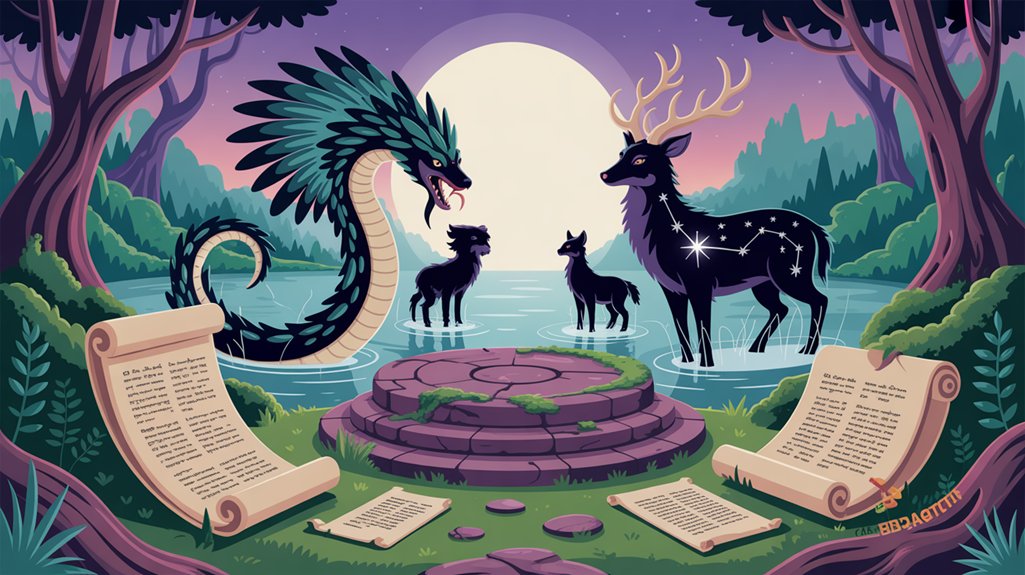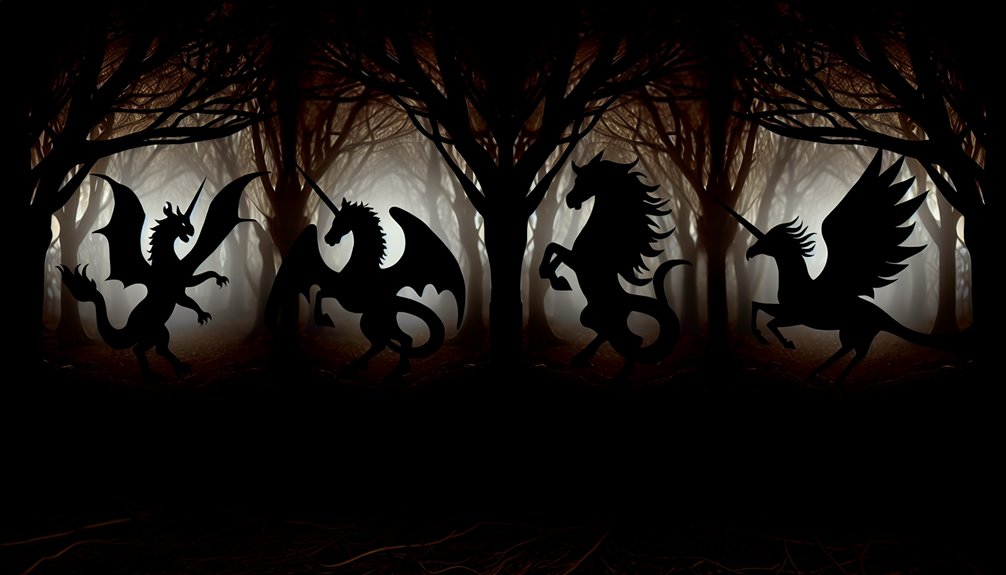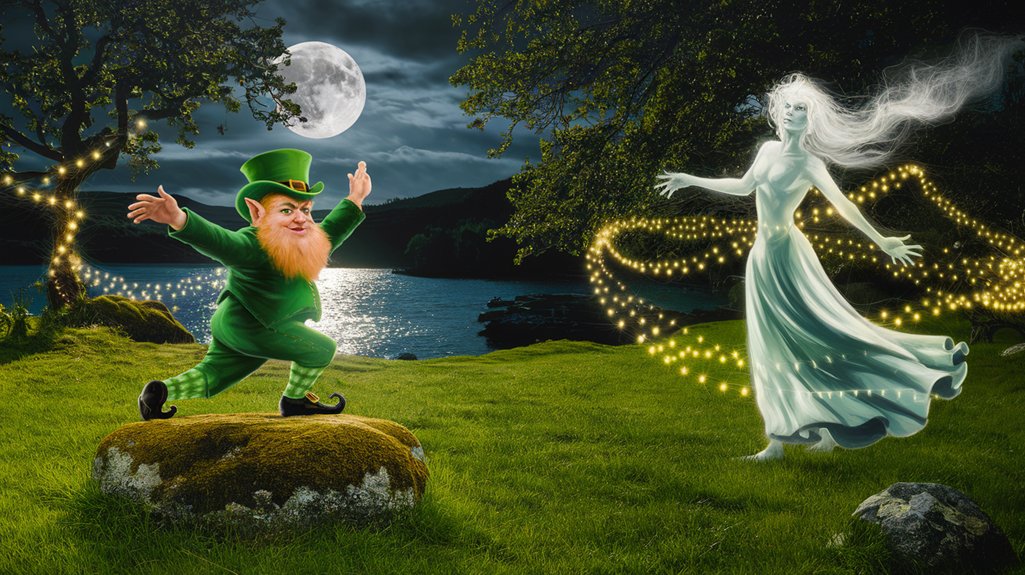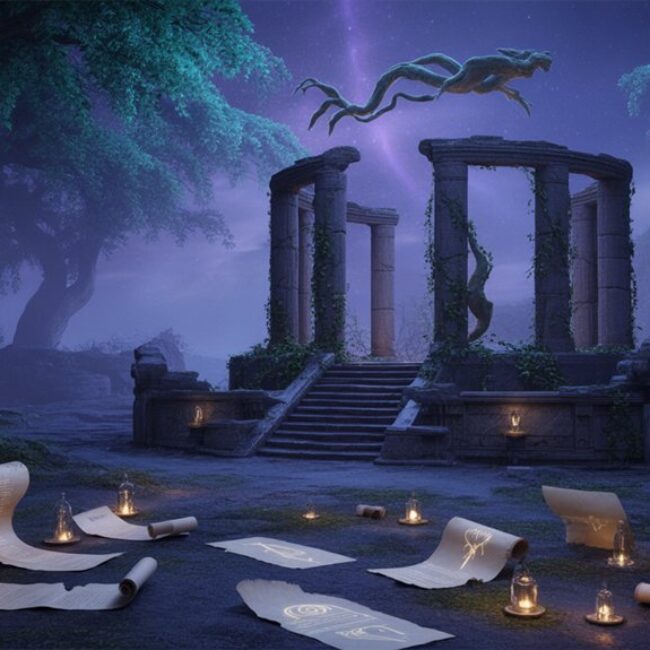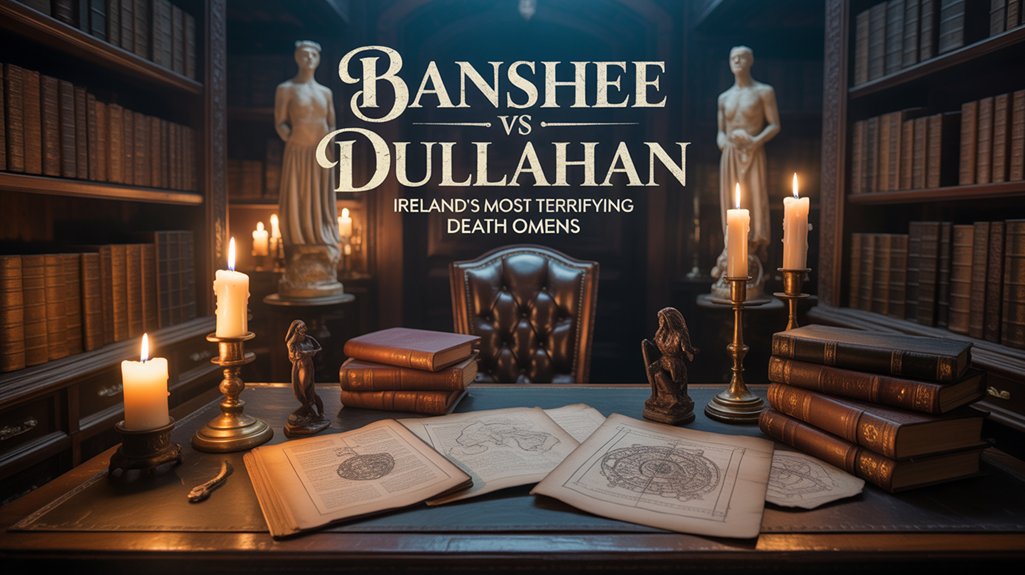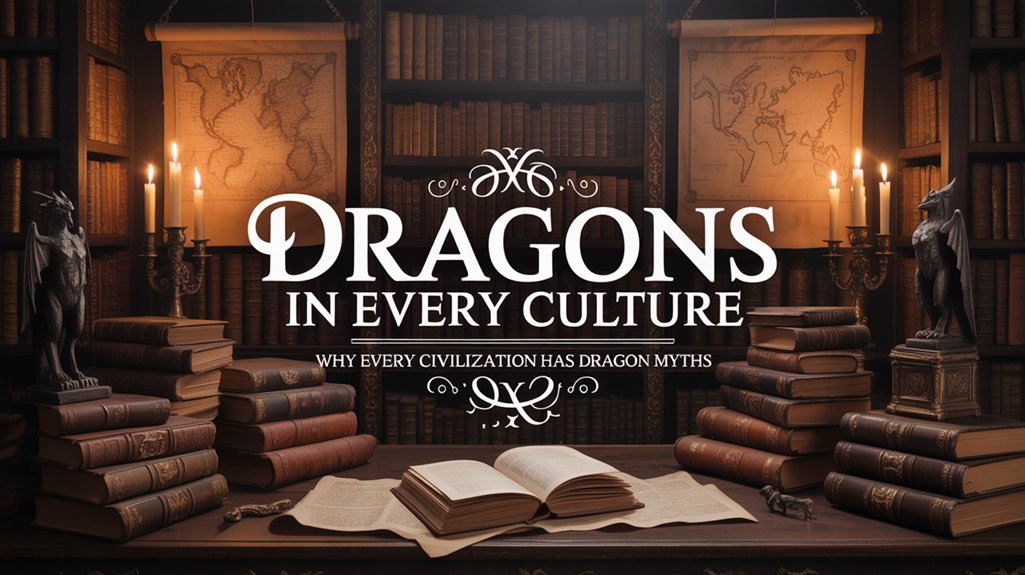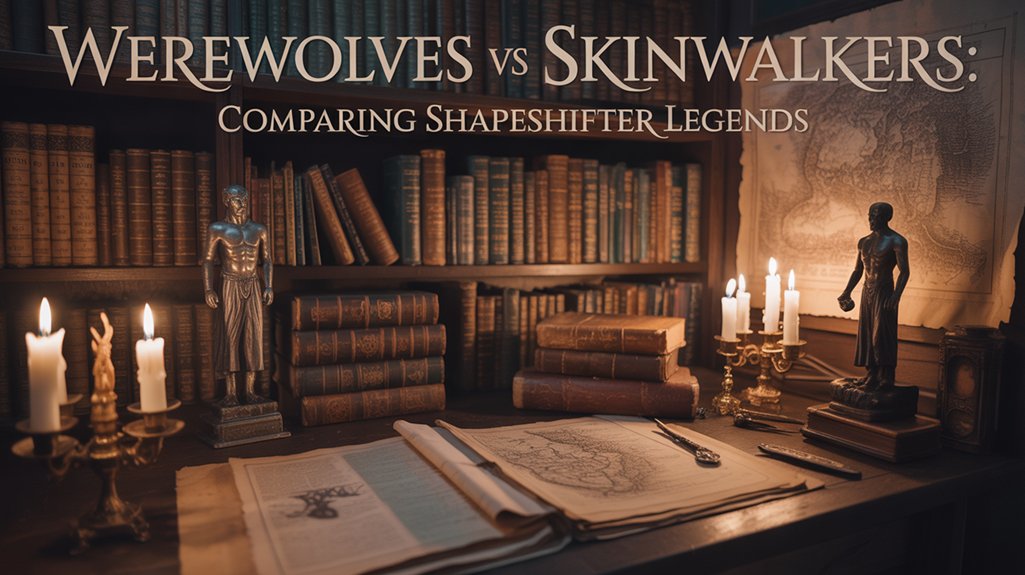You’ve encountered sanitized versions of mythological beings in modern media, but authentic creatures like the skinless Nuckelavee of Orkney’s windswept shores, the Ahuizotl lurking beneath Lake Texcoco’s sacred waters, and the towering Leshy of Slavic woodlands once carried far more eldritch power than their contemporary Halloween counterparts suggest. These chimeric guardians—from Ireland’s keening Bean-sidhe to Japan’s honor-bound Kappa—served as cultural gatekeepers between realms, their forms reflecting humanity’s primal fears of oceanic depths, desert vastness, and forest shadows before Christianity’s scribes began their systematic erasure of competing cosmic narratives.
Table of Contents
ToggleKey Takeaways
- Bean-sidhe transformed from sacred Celtic death messengers into Halloween caricatures, losing their profound role as Otherworld gatekeepers.
- Norse mythology contained multiple world serpents beyond Jörmungandr, including Níðhöggr and others referenced only in ancient runestones.
- Ahuizotl of Lake Texcoco were Aztec water guardians with dog bodies and human hands, now forgotten lake monsters.
- Arabian Ghuls were ancient desert shapeshifters from 2000 BCE Mesopotamian traditions, predating modern horror interpretations.
- Slavic Leshy woodland protectors evolved from sacred grove guardians to diminished folklore figures through cultural modernization.
Shadow Dwellers of Northern Seas: The Nuckelavee and Its Kin
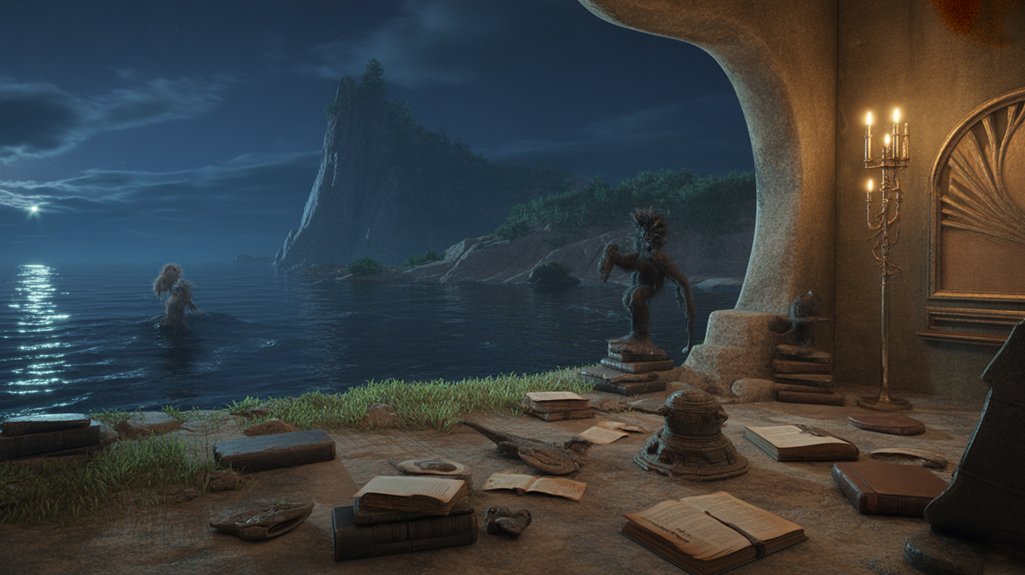
Where do nightmares take physical form, rising from the churning depths of storm-lashed seas to terrorize coastal settlements with their eldritch presence? You’ll find your answer in the Orkney archipelago, where ancient Gaelic whispers speak of the Nuckelavee—a chimeric abomination that haunts the liminal spaces between land and sea.
This maritime horror emerges from Norse-Celtic traditions, its form defying mortal comprehension. Half-horse, half-man, skinless and raw, with pulsing sinews exposed to salt spray and moonlight. The creature’s breath withers crops, its passage brings pestilence.
Ancient knowledge reveals kindred entities across northern waters. The Cabyll-Ushtey of Manx lore. Iceland’s skeletal Nykur.
You’re witnessing humanity’s primal fear of the ocean’s depths, where tidal forces meet supernatural dread. These beings represent the sea’s dual nature—provider and destroyer, mother and monster. Their legends persist because they embody truths about nature’s terrible beauty and mankind’s fragile existence beside endless waters. Like the revered Japanese mythology that gave us Amaterasu, these dark maritime tales form part of humanity’s vast tapestry of mythological understanding.
Aztec Water Guardians: Ahuizotl and the Lake Monsters
How does death arrive in the sacred waters of Tenochtitlan, where jade-green canals wind through floating gardens and temple shadows? You’ll find your answer in the ahuizotl, those eldritch Aztec guardians whose chimeric forms haunted Lake Texcoco’s depths from the 14th century onward.
These aquatic legends possessed canine bodies, human hands, and grasping appendages sprouting from their tails—tools for drowning the unwary. You’d recognize their victims by telltale signs: bodies bearing only puncture wounds at fingernails, toenails, and eyes, while internal organs vanished mysteriously.
| Physical Traits | Hunting Methods |
|---|---|
| Dog-like body, human hands | Mimics drowning children’s cries |
| Prehensile tail-hand | Creates whirlpools, undertows |
| Waterproof fur coat | Feeds on eyes, nails, teeth |
The Nahuatl-speaking peoples understood these creatures as divine enforcers, punishing those who violated aquatic sanctity. When Spanish conquistadors arrived, they dismissed such beliefs. Yet fishermen’s whispered warnings persisted, echoing through centuries of cultural suppression.
Like the Greek god Pan’s cult that centered in Arcadia before spreading to other regions, the ahuizotl’s influence extended far beyond its original lake domain into the broader Mesoamerican consciousness.
Slavic Forest Spirits: Leshy and the Woodland Protectors
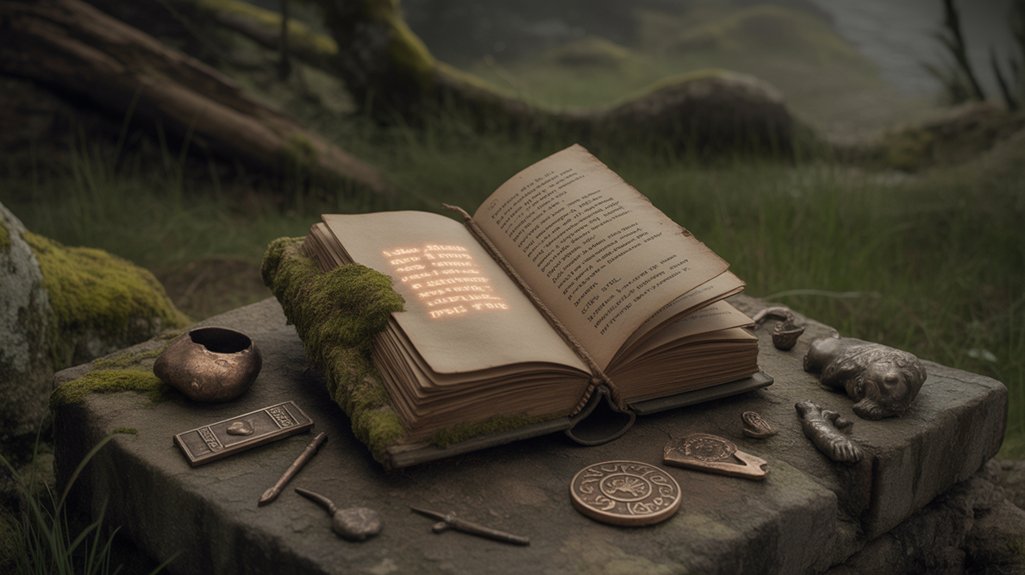
When twilight descends upon the birch groves and pine forests of Eastern Europe, you enter the domain of the leshy—those shape-shifting guardians who’ve protected Slavic woodlands since pre-Christian times. These eldritch beings transcend simple categorization, embodying the wild’s untamed essence through their chimeric nature, appearing as towering giants crowned with moss or diminutive forest dwellers cloaked in bark and leaves.
Regional taboos surrounding these woodland protectors vary dramatically across Slavic territories. You’ll find that lore vs folklore distinctions blur when examining leshy accounts—formal ethnographic records merge seamlessly with whispered village stories. In Russia, they’re benevolent guides for respectful travelers; in Poland, malevolent tricksters leading hunters astray.
Ancient chronicles. Dense undergrowth rustling.
Weathered manuscripts whisper secrets while unseen creatures stir beneath tangled branches, bridging documented history with living wilderness mysteries.
Their dominion encompasses sacred groves where pre-Christian rituals once flourished, their voices echoing through centuries of suppressed traditions. You’re witnessing guardians of ecological wisdom, beings who demand reciprocity between human ambition and natural preservation—elusive sentinels maintaining boundaries you’ve forgotten exist.
Celtic Harbingers: Bean-Sidhe and the Otherworld Messengers
You’ll find the Bean-Sidhe, those eldritch keening women of ancient Ireland, emerging from the mists of pre-Christian Celtic cosmology as otherworldly messengers whose mournful wails heralded death’s approach across the emerald countryside. These spectral harbingers, bound to specific bloodlines through ancestral contracts forged in the liminal spaces between mortal and faerie realms, once commanded reverence and terror in equal measure—their banshee cries piercing the veil between worlds with prophetic certainty.
Yet modernity’s relentless march has relegated these once-feared messengers to mere Halloween caricatures, their sacred role as psychopomps reduced to chimeric shadows haunting only the periphery of contemporary consciousness.
Origins in Ancient Ireland
Where do the mournful cries that pierce the veil between worlds originate, if not from the mist-shrouded hills of ancient Ireland, where the Bean-sidhe first emerged as harbingers of fate itself? You’ll trace their eldritch genesis to pre-Christian Celtic society, where territorial spirits bound themselves to ancestral bloodlines through sacred covenant. These chimeric entities emerged from storytellers’ traditions dating to Ireland’s Bronze Age settlements, their mythic migration flowing through generations of oral transmission.
Ancient druids recognized Bean-sidhe as liminal guardians dwelling between mortal realm and Otherworld. They weren’t malevolent specters but protective ancestors maintaining spiritual watch over their descendants. Archaeological evidence suggests their worship centered around burial mounds, stone circles marking sacred boundaries. Their keening voices—neither wholly human nor entirely supernatural—announced impending death while offering comfort to grieving families, establishing Ireland’s most enduring otherworldly tradition.
Wailing Death Omens
How does one distinguish between wind’s natural howl and the otherworldly keen that announces death’s approach, when Bean-sidhe voices carry across Ireland’s darkened landscapes like spectral warnings from beyond? These eldritch harbingers, bound to ancient bloodlines through hidden lore spanning millennia, manifest as chimeric entities straddling mortality’s threshold.
Their manifestations follow precise patterns:
- Keening Songs – Mournful wails preceding death by hours or days
- Spectral Appearances – Gray-cloaked figures washing burial shrouds in moonlit streams
- Ancestral Bonds – Exclusive attachment to noble Irish families
- Ritual Echoes – Traditional funeral lamentations mirroring their otherworldly calls
You’ll recognize their presence through bone-deep recognition—an ancestral memory awakening. These otherworld messengers don’t merely predict death; they bridge realms, carrying souls toward inevitable transition with voices that resonate through Celtic consciousness.
Modern Cultural Decline
Why have these ancient voices grown silent in our digitized world, when once their otherworldly presence commanded reverence throughout Ireland’s countryside? You’re witnessing the systematic erasure of eldritch wisdom as smartphone screens replace moonlit vigils. The Bean-sidhe’s keening no longer echoes through mist-shrouded valleys where your ancestors once recognized her otherworldly geography as sacred cartography.
| Traditional Era | Transitional Period | Modern Decline |
|---|---|---|
| Oral transmission | Written folklore | Digital fragments |
| Culinary taboos observed | Rituals weakening | Traditions forgotten |
| Communal recognition | Individual skepticism | Cultural amnesia |
Corporate algorithms can’t process chimeric encounters or ancestral warnings that transcend rational boundaries. You’ve traded authentic connection to the Otherworld for sanitized entertainment, losing the profound understanding that Bean-sidhe weren’t mere superstition but gatekeepers between realms, their lamentations mapping territories your liberated spirit desperately needs to reclaim.
Japanese Shapeshifters: Kappa and the River Yokai
Though Western folklore often dominates discussions of shapeshifting entities, Japan’s ancient waterways harbor some of mythology’s most enigmatic and enduring metamorphic beings—the kappa and their fellow river yokai. You’ll discover these chimeric entities embody philosophical parallels between humanity’s relationship with nature’s untamed forces, their legends persisting through centuries as cautionary tales woven into Japan’s cultural fabric.
These eldritch water-dwellers manifest through four primary characteristics:
- Physical duality: Turtle-like shells concealing humanoid forms beneath murky surfaces
- Supernatural strength: Capable of drowning adult humans through cunning manipulation
- Honor-bound nature: Compelled to bow when greeted, spilling life-sustaining water from cranial depressions
- Shapeshifting versatility: Assuming human appearance to lure unsuspecting victims
Contemporary urban legends still whisper of kappa encounters, particularly around rural irrigation channels where ancient beliefs intersect modern skepticism. You’re witnessing mythology’s remarkable persistence—these aquatic shapeshifters represent humanity’s primal recognition that water sources demand both reverence and wariness.
Arabian Sand Phantoms: Ghuls and the Desert Terrors
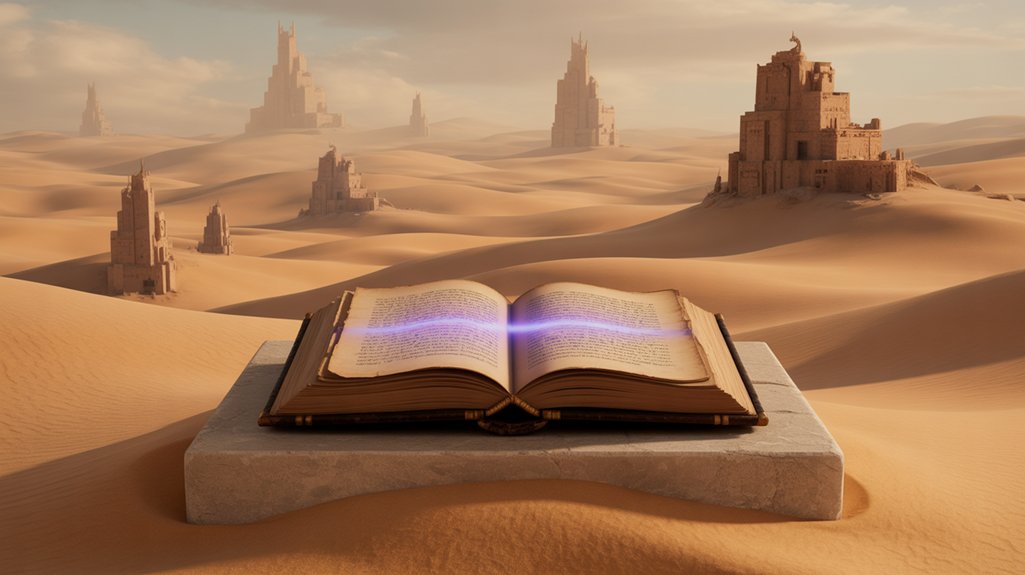
You’ll discover that the ghuls of pre-Islamic Arabian folklore, first documented in 7th-century texts, emerged from the eldritch convergence of Bedouin oral traditions and ancient Mesopotamian demonology—shapeshifting entities that haunted the liminal spaces between oasis sanctuaries and the vast, star-swept emptiness of the desert. These chimeric phantoms possessed an unsettling ability to assume human form, luring travelers with familiar voices carried on hot winds before revealing their true nature: beings of smokeless fire with backward-facing hands and the cunning intelligence of predators who’d mastered the art of psychological terror.
Though modern scholarship often reduces them to mere cautionary tales, the ghul’s cultural legacy persists in contemporary horror literature and film, their ancient hunger for human flesh transformed into metaphors for the unknowable dangers that lurk beyond civilization’s fragile borders.
Ancient Ghul Origins
Where did the shifting sands of Arabia first whisper tales of the ghul, those shape-shifting devourers that haunted the pre-Islamic consciousness? You’ll discover their mythic origins stretch back to Mesopotamian antiquity, where eldritch entities first stalked desert caravans in 2000 BCE.
These chimeric beings emerged from folklore ethics rooted in survival wisdom:
- Babylonian predecessors – Ancient tablets describe similar desert demons
- Nomadic oral traditions – Bedouin stories preserved across millennia
- Trade route warnings – Merchants’ tales of supernatural encounters
- Cultural synthesis – Persian and Arabian mythologies intertwining
You’re witnessing humanity’s primal need to explain the unexplainable. Desert mirages, bleached bones, vanished travelers—all demanded supernatural explanation. The ghul embodied raw desert terror, transforming innocent encounters into deadly traps through illusion and hunger.
Desert Shapeshifting Abilities
When darkness descended upon the endless dunes, the ghul’s most terrifying attribute manifested—its protean ability to assume any form that would lure unsuspecting victims to their doom. You’d encounter these eldritch beings through their chimeric transformations, recorded across centuries of desert folklore. Their shapeshifting legends describe creatures that could mimic beloved family members, beautiful maidens, or wounded travelers crying for help.
| Form Assumed | Purpose | Cultural Region |
|---|---|---|
| Beautiful Woman | Seduction/Luring | Arabian Peninsula |
| Lost Child | Parental Instinct | Mesopotamian Desert |
| Wounded Traveler | Compassion Trap | North African Sahara |
| Familiar Relative | Trust Exploitation | Levantine Wilderness |
These transformations weren’t mere illusions—they represented fundamental alterations of flesh and bone, allowing ghuls to exploit humanity’s deepest vulnerabilities and desires for connection in the vast, isolating wilderness.
Modern Cultural Legacy
These ancient metamorphic terrors have woven themselves into the fabric of contemporary storytelling, their shadowy influence permeating modern literature, cinema, and digital media with an intensity that speaks to humanity’s enduring fascination with desert malevolence.
You’ll discover their eldritch presence across diverse platforms:
- Horror cinema resurrects ghul archetypes through chimeric antagonists
- Video games incorporate desert shapeshifters as boss encounters
- Urban fantasy novels reimagine sand phantoms in metropolitan settings
- Graphic novels visualize their transformative capabilities with stunning artistry
Within proper mythic taxonomy, these entities transcend mere monsters—they’re cultural repositories. Ethical storytelling demands you acknowledge their Arabian origins while exploring their universal themes. Their desert-born terror continues resonating because it embodies humanity’s primal fears: isolation, deception, the unknown lurking beyond civilization’s fragile boundaries. Ancient wisdom persists.
Norse World Serpents: Jörmungandr’s Forgotten Siblings
How many colossal serpents encircled the ancient Norse cosmos before Jörmungandr claimed dominion over Midgard’s oceanic boundaries? You’ll discover that mythic taxonomy reveals an eldritch pantheon of world-serpents, their names whispered in fragmentary eddic verses, their forms obscured by centuries of sibling vanishing from collective memory.
Before Loki’s monstrous offspring seized the cosmic spotlight, primordial wyrms coiled through the nine realms. Níðhöggr gnawed Yggdrasil’s roots in Niflheim’s depths. Yet archaeological evidence suggests other serpentine titans: Upplanda runestones reference “Ormr Alheimr”—the All-Realm Serpent—whose chimeric form supposedly bridged multiple cosmic layers simultaneously.
These forgotten leviathans possessed distinct dominions. One governed atmospheric currents between Asgard and Vanaheim. Another lurked beneath Jötunheim’s frozen rivers, its scales catching aurora-light through ice-carved chasms.
Their erasure wasn’t accidental. Christian scribes systematically eliminated competing world-serpents, consolidating mythological power into singular, controllable narratives. You’re witnessing deliberate cultural archaeology—recovering what orthodoxy buried.
Frequently Asked Questions
How Do Modern Archaeologists Verify the Historical Existence of These Mythical Creatures?
You can’t verify mythical creatures‘ historical existence through traditional archaeological methods. Instead, you’ll discover that evidence gathering reveals cultural truths—pottery shards depicting chimeric forms, ancient texts describing eldritch encounters, burial sites with protective talismans. The myth vs reality divide dissolves when you realize these beings existed as psychological archetypes, spiritual metaphors. You’re uncovering humanity’s deepest fears and desires, not biological specimens. Archaeological fragments whisper of collective consciousness, not corporeal proof.
What Role Did Climate Change Play in the Disappearance of These Legends?
Like whispered secrets carried on dying winds, climate shifts sculpted disappearance patterns across ancient landscapes. You’ll discover that shifting trade routes fractured story diffusion networks, leaving extinction myths stranded in isolated pockets. As glaciers retreated and deserts expanded, the eldritch creatures you seek vanished from collective memory. Modern archival methods reveal how environmental upheaval severed the chimeric threads connecting disparate cultures, ultimately silencing the voices that once breathed life into these forgotten beings.
Are There Any Documented Sightings of These Creatures in Contemporary Times?
You’ll discover that mythic sightings persist across continents—chimeric forms glimpsed in Appalachian hollows, eldritch entities photographed in Siberian taiga, ancient guardians witnessed near sacred Aboriginal sites. Contemporary folklore weaves these encounters into digital testimonies, blurring boundaries between ancestral memory and modern experience. While skeptics dismiss such reports, you’re witnessing humanity’s unbroken connection to liminal realms. These sightings aren’t mere delusion—they’re cultural DNA expressing itself through collective unconscious manifestations.
How Did Trade Routes Influence the Spread of These Mythical Creature Stories?
Like arteries pumping lifeblood through ancient civilizations, trade networks carried chimeric tales across vast distances. You’ll discover how maritime routes convert localized folklore into transcontinental mythologies—merchants didn’t just transport silk and spices, but eldritch narratives of sea serpents, djinn, and shapeshifters.
Phoenician traders spread dragon legends from Mesopotamia to Mediterranean ports.
Silk Road caravans carried chimeric beasts between East and West.
You’re witnessing mythology’s evolution through commercial exchange.
What Methods Do Folklorists Use to Reconstruct Lost Variations of These Myths?
You’ll explore folklore reconstruction through comparative philology, tracing linguistic roots across ancient texts. Regional variant analysis reveals how stories morphed—chimeric fragments scattered through forgotten manuscripts. Spotty translation issues complicate your quest, but you’ll cross-reference eldritich symbols, decode ritualistic patterns, and map cultural diffusion paths. Archaeological evidence whispers secrets. Oral traditions carry buried truths. You become both detective and mystic, reconstructing these lost beings from scholarly fragments and ancestral memories.
Conclusion
You’ve traversed seven eldritch domains where forgotten chimeras once held dominion over human consciousness. Consider this: archaeologists estimate 90% of mythological entities documented in pre-industrial societies have vanished from collective memory. These spectral guardians—nuckelavee, ahuizotl, leshy—weren’t mere folklore but sacred knowledge systems encoding environmental wisdom, social boundaries, cultural taboos. Their absence leaves humanity spiritually impoverished, disconnected from ancestral understanding. You’re witnessing the final echoes of primordial truths, dissolving into modernity’s relentless march toward mythological amnesia.

